Plus all types of religious/cultural/sports facilities
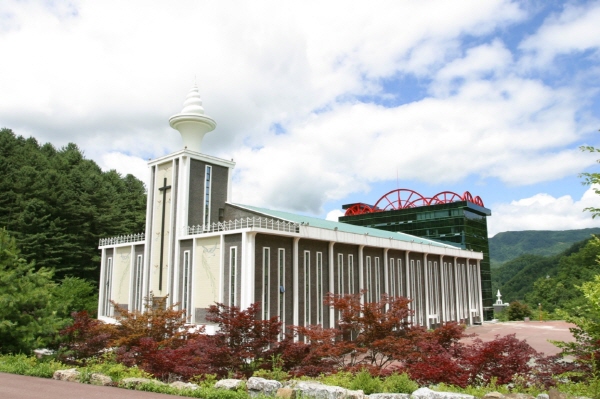
By Publisher Lee Kyung-sik with Editors Choi Dug-ha, Cho Kyung-hee, Kim Jung-mi
After about an hour’s run by car from Seoul in the northeastern direction, one comes to a county named Gapyeong which has a population of over 62,000 people--belonging to the Gyeonggi Province.
One of the outstanding features of Gapyeong, perhaps, is a large religious estate named Algok- seongjeon Complex which has been established by the Holy Eden Church through decades of years. Algok means ‘grain’ and Seongjeon means ‘temple’, so Algok-seoungjeon is Grain Temple. One would say that the Holy Eden Church is one of the few largest religious estates in Korea.
The Holy Eden Church in Gapyeong has an estimated total of 24 large buildings with an overall floor space of around 21,800 pyeong (approx. 72,000 square meters or 18 acres) built on a land lot sprawling over some 500,000 pyeong (approx. 1.65 square kilometers or 408 acres).
The land favorably compares to over one half of the entire land space of the Yeoido Islet in Seoul where the National Assembly Complex is situated--together with various other landmark buildings, including the 63-story Yuksam Building and the Twin-Tower LG Group headquarters.
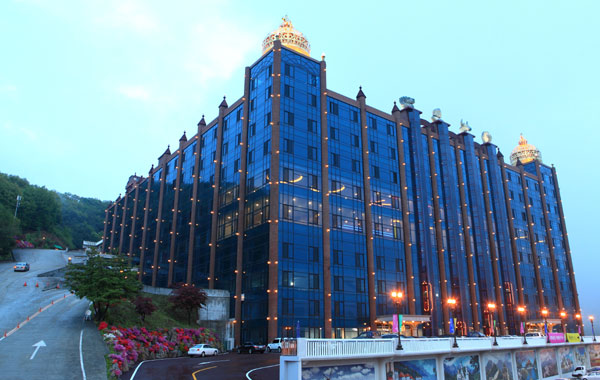
The figures of the Holy Eden Church in Gapyeong would give one a glimpse into what kind of large land and building facilities make up the famous religious estate of the Holy Eden Church. The Church has a long string of wonders.
On July 6, 2019, Publisher- Chairman Lee Kyung-sik of The Korea Post media and his reportorial team visited the church estate for a first-hand report, and toured various interesting facilities and sites of the Church guided by Dr. Yoon Sang-hak, the Public Relations director of the Church, and another senior member, Mr. Yoon Jin-deok.
Offhand, the theater named Munhwa-eui Jeondang (or the Culture Hall) stood out of all the physical facilities of the Church. According to Dr. Yoon, the building has a total of 6,170 seats, more than twice the size of the Sejong Cultural Center in Seoul, and is rated to be the largest theater in the world.
Here is what came into the eye of the visitors from The Korea Post media, including Vice Chairman Choi Dug-ha, Vice Chairperson Cho Kyung-hee, on the way to the Algok Seongjeon. The 46th National Route, which is also called the Gyeongchun Highway, connects famous tourist-spots estates, such as the Nami Island, the Daeseong-ni Resort and the Cheongpyeong Resort.
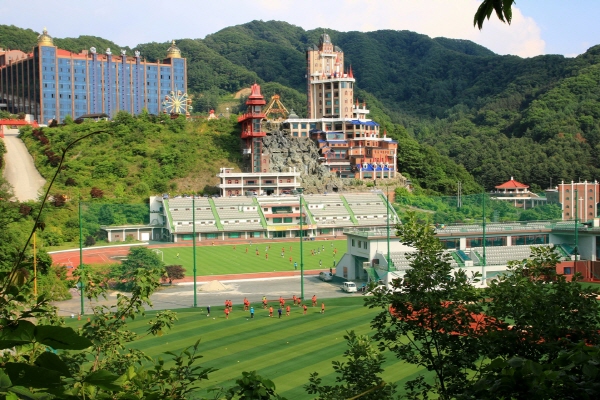
Driving along the road, you see large buildings located about 6 kilometers past the Cheongpyeong Railroad Station. The buildings house a large-scale rest area (Beotkkot-gil Rest Area, meaning of Cherry Blossom Rest Area), a sports town, a recreation center (Youth Training Center), a wedding hall and a large farm products center.
Many people are surprised by the large buildings that suddenly emerge in Cheongpyeong, where the national routes are covered with mountains and lush green fields. Even on top of one building (Sangcheon Youth Training Center), a stately Eiffel Tower model of Paris emerges, arousing curiosity among the visiting tourists. Some ask, "Why are such wondrous facilities built in this sparsely populated area?"
This is the entrance to Algok-seongjeon, which is home to the Holy Eden Church. Road-side facilities are only a small fraction of the Algok-seongjeon Complex. If you walk about one kilometer down the side road of the Beotkkot-gil Resting Area, you are greeted by a large 12-story building (Hotel Whitestone) that is not likely to be in the deep mountains.
If you look up the mountain from there, you will see a building that looks like a Medieval castle of Europe, 'Dream Castle', and a big performance hall, ‘Culture Center’. These buildings are surrounded by U-shaped mountains and are nowhere to be seen from the roads.

There are so many other wondrous things. There is a cultural-sports complex which boasts various cultural and sports facilities such as a natural grass football pitch, a ballpark, an amusement park, and a church (Algok-seongjeon) on hundreds of acres of land in Sangcheon-ni, Cheongpyeong- myeon. How and when have these buildings been built? The Korea Post media filed a report on the Algok-seongjeon Complex which has been built for over 30 years.
A Hotel with a large gym and an outdoor performing hall:
We drove about a kilometer past a sign, ‘Entrance to Algok-seongjeon’ on the back of the Eden Agricultural Products Center. It is also a hiking trail to Jubalbong (489m) of Homyeong Mountain, and there is nothing special about it in winter.
However, cherry trees are densely planted on both sides of the road, and in spring the area is well known among cycling or trekking experts under the name of ‘Eden Cherry Blossom Road’ or ‘Sangcheon Cherry Blossom Road.’ In spring and fall, the road is crowded with cycling club members.
The road is called the ‘Edenbeotkkot-gil’ meaning ‘Eden Cherry Blossom Road.’ The first thing that came into sight after the Cherry Blossom Road was a magnificent 12-story brown building that was long enough not to be seen by the side. "This is Hotel Whitestone," said Dr. Yoon, the Public Relations director of the Holy Eden Church.
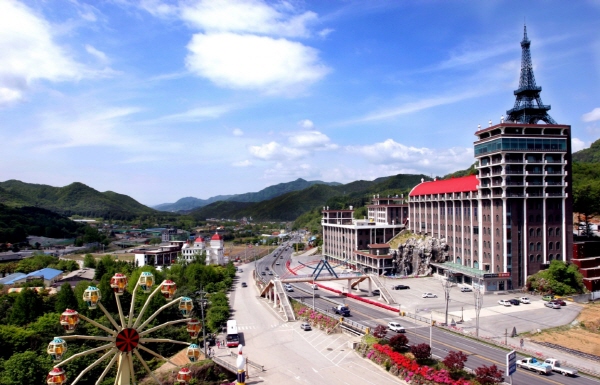
Considering the hotel’s facade alone, the number of rooms was expected to exceed 2,000, but the actual number of them is about 600. While wondering why, the question was solved by looking at the hotel from the walkway above the hotel. The hotel consisted of Donggwan, Junganggwan, Seogwan and an annex, and there was an indoor gymnasium on the 12th floor of the annex.
As the hotel was built on a slope at the foot of the mountain, we took the elevator to the 12th floor, then took the annex elevator to go up six more floors, and we were connected to the hiking trail. From the top floor of the hotel, we looked down at the hotel and saw an open stage surrounded by the hotel's main hall, and the annex. The stage is utilized as a large outdoor performance hall. Dr. Yoon, the director of communications at the Church, said: "The indoor gymnasium in the hotel is large enough for 2,000 people to watch games, and the outdoor concert hall allows visitors to see the performance on the mountain trails, so that the capacity is unlimited."
Currently, large five-star hotels in Seoul, such as Hotel Shilla, Grand Hyatt Seoul and Grand Intercontinental, all have room sizes of 500 to 600, similar to those at the Hotel Whitestone. Hotel Whitestone first will open its 100-room East Wing next year. With all the requirements of the five-star hotel, as well as sports facilities and a concert hall, the hotel will be opened with a five-star hotel rating upon completion and is known as the only hotel that can host international competitions in Gyeonggi-do Province, where Seoul is located.

The promenade is said to present a spectacular view in the blooming spring, with pine trees and various other trees flowering at the same time. If you walk up and down a walking path connected to the rooftop of the hotel for about 30 minutes, you can reach the Culture Center, a large performing hall. On the 10th floor, there is a wide lounge, which allows visitors to enjoy tea and dessert while viewing the surrounding scenery.
After leaving Hotel Whitestone, we went 500 meters up, and on the right, we saw a large crossed chapel and annexed buildings, and on the left a building and a football field that looked like a castle in the fairy tale. First, we climbed left to the Algok Sports Complex. The football stadium, which is covered with natural grass, is equipped with a track and field tracks which meet the international competition standards, has a dressing room, a fitness club, and an annex building with a snack bar under the stands. The games can be seen by more than 2,000 people.
International Standard Sports Facilities:
After being completed in the early 2000s, the National Sports for All Festival hosted by Gyeonggi Province was held in 2003 at the Algok Sports Complex, and many other teams, including the women's national soccer team, the youth team, Incheon United FC and Pohang Steelers FC have since trained here.
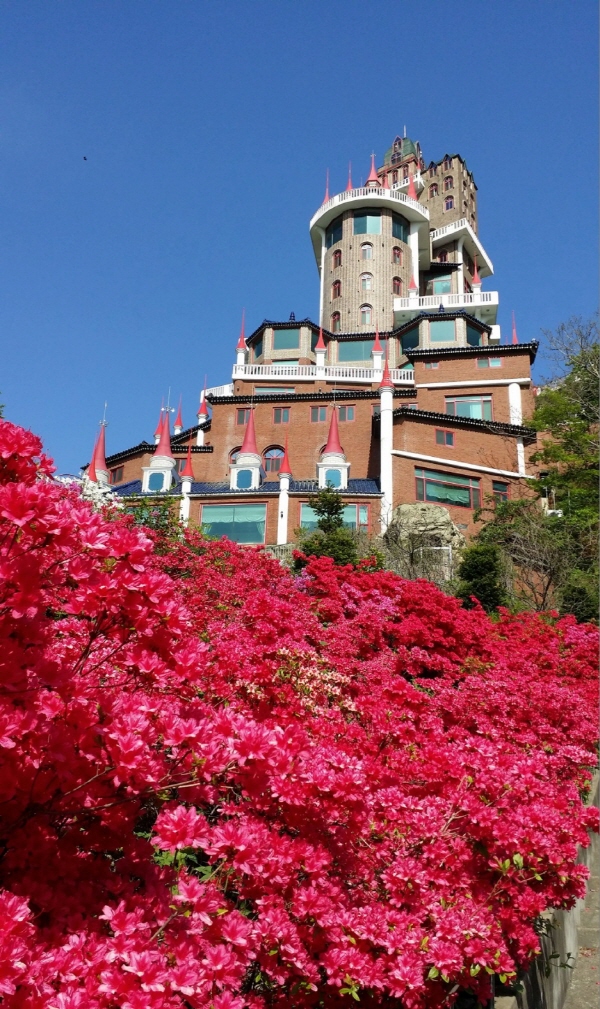
It is also a place where various training and events are held, such as the Korea Football Association's leadership training, friendly football competitions for entertainers, and a football tournament for veterans' organizations. When we went down to the ground of the football field, we thought it was an ideal place for training because the natural grass was densely covered and the air was clear in the mountains, while the spectators' seats were designed to prevent strong mountain winds. In addition, health clubs and restaurants in the annex building were also spacious enough to accommodate large numbers of people. There were motels, villas, and other accommodations around here. We thought it would be an ideal training facility.
Dr. Yoon said: "When Pohang Steelers FC underwent training here, Manager Hwang Sun-hong remarked, 'This is the best football field I have been to in Korea in many ways, especially the ground, resting facilities, and the surrounding environment, and even when compared with pitches of other countries, it never lags behind. Some players who suffered from back or knee pains got better as they took advantage of the good grass density in our area.'"
There is a football stadium above and a ballpark below the annex building, which has a fitness club and a shower room, a broadcasting room, a referee's room, an indoor viewing room and eateries.
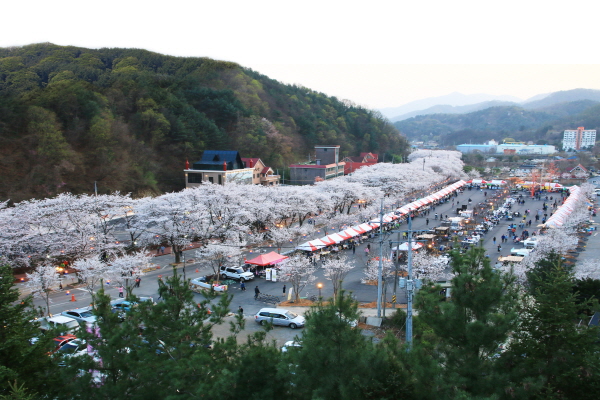
Most of the walls are glass windows, so you can see both football and baseball games from inside the building. The baseball park is also built according to international standards, and amateur and social baseball teams are frequently playing and training here.
These huge sports facilities have been built in line with the philosophy of Reverend Lee Young-soo, founder of the Holy Eden Church, that ‘only when the body is healthy it makes the spirit as a believer sound.’ Dr. Yoon added: "At first, it was intended for use by the church members, but since it is a large facility that is rarely seen in the region, many people wanted to use it and so we opened it up for local residents and organizations."
The sports facilities of the Holy Eden Church are not just football and baseball fields. In addition to a two-story indoor gymnasium, Eden Sports Town next to the Beotkkot-gil Rest Area has an indoor swimming pool, bowling club. In addition, there are indoor tennis court and a golf driving range, all built to meet international competition standards.
Dr. Yoon said that the Algok Sports Complex held an annual soccer tournament for veterans' families and received two appreciation plaques (once in 2008 and again in 2014) from the head of the Veterans Affairs Committee in Gapyeong County.
It received the National Sports Promotion Foundation’s Award in 2007 in recognition of its contribution to the development of a healthy sports culture and supplementation of sports leisure facilities in the underdeveloped northeastern part of Gyeonggi Province.

In 2008, the Algok Sports Complex also was awarded an appreciation plaque from the Korea Football Association and a citation from the Minister of Knowledge Economy in recognition of its contribution to national soccer development.
Passing through the football field and the ballpark, we arrived at a castle-shaped building with several pointed spires. Built on a steep slope, the building is called ‘Castle of Dream.’ Made with unusual shapes by utilizing the shape of a sloping mountain, it houses a Korean restaurant, a steakhouse, a skyline and a banquet hall.
‘Castle of Dream’ and Amusement Park that stimulate children’s curiosity:
After stepping into M Lounge, a skyline on the 5th floor of the Castle of Dream, we sat on a window seat with a full window, and the buildings we had seen so far were opened at a glance.
M Lounge offers a variety of drinks and simple snacks, while Korean restaurants and steak houses are also opened. Restaurants seemed to have a different atmosphere as they had an unusual appearance sitting in the middle of a rocky mountain, as well as many outdoor seats. As we went a little further up the outdoor elevator of the Castle of Dream, there emerged a more interesting scene.
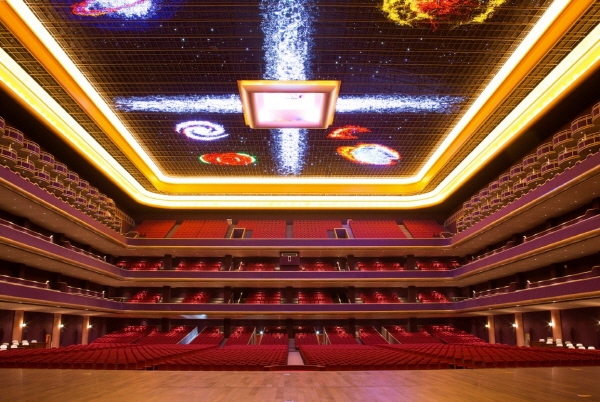
It was the first time we have seen an amusement park in high mountains in Korea. It is open until 6 p.m. in spring and summer and 5 p.m. in autumn and winter. Especially in the summer, we feel we can enjoy ourselves with the cool breeze in the amusement park.
Also, parents of preschool or elementary school children prefer the entire amusement park as it is small and cozy enough to be seen at a glance. Another advantage of this park is that there is no entrance fee and riders pay for each ride. As time passes, the hotel and concert hall will likely become more popular, although it is now visited by many local residents, including Christians and those living in the Gapyeong area.
Next to the amusement park is an outdoor security education center displaying old-type fighter jets, tanks and artillery. It is an effective place to bring in fighter jets and tanks that were used in the military and display them along with relevant historical records to stimulate children's curiosity and provide security education. There were also five to six life-size large dinosaur models next to them, which were created and donated for children by a faithful member of the Holy Eden Church.

Korea’s largest Indoor Performing Hall:
Behind the amusement park stands a building as big and magnificent as Hotel Whitestone. It is a large-scale theater called ‘Culture Center.’ Four stone carvings at the top of the building caught the eye. Each was the image of a lion, a man, a cow, and an eagle, which are said to represent the archangels close to God. At both ends of the building, there is a golden crown, which represents the glory that two olive trees will receive, according to Yoon.
The expansive theater lobby was on the sixth floor, and on the wall of the lobby connecting the sixth and seventh floors are paintings depicting the spiritual experiences of Reverend Lee Young-soo. There are many paintings on the wall that depict spiritual scenes, such as Lee’s meeting with God and the sight of the Heavenly Kingdom.
In addition, there were four transparent sightseeing elevators in front of the building that could command the view unfolding under the mountain from inside them. Of note, these elevators are able to view the outside without being obstructed, as there were no horizontal structures on each floor.
The lobby, decorated with high ceilings and unusual lights, was also amazing, as we were surprised the moment we opened the doors of the Culture Center.
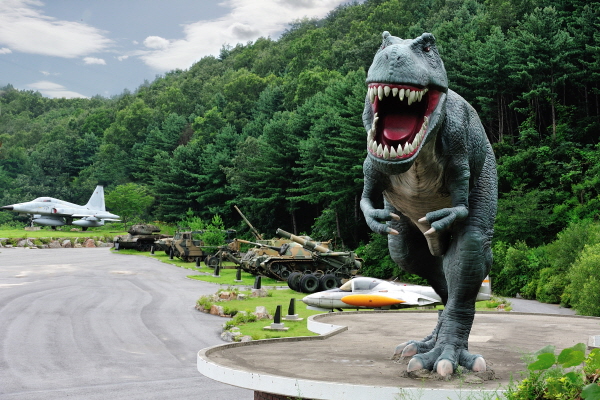
This is because a huge performing hall that we have never seen before was opened before our eyes. It was overwhelmed by its splendor, as it was filled with red carpets and red chairs, and the ceiling showed images of galaxies and the Milky Way with 480,000 LED lights. In the middle of the ceiling was the image of God sitting on the throne that Reverend Lee Young-soo had seen in heaven.
As the floor space of the performing hall reached 70,000 square meters, it took more than three minutes to walk into the back entrance and to the front stage. It has as many as 6,170 seats. Compared with the 3,022-seat Sejong Center for the Performing Arts and the 2,200-seat Seoul Arts Center Opera House, it is more than double the size of the largest theaters in Korea so far. The screen is also 34 meters wide and 13.8 meters long, the same size as the screen of Lotte Cinema World Tower, which is the largest in Korea, and the stage was so big that the screen didn't look particularly big. Movies were screened for the congregation, and it was rated perfect in terms of quality and sound.
The National Center for Performing Arts in Beijing, China which is said to be the world's largest, also has 5,473 seats, while the Sydney Opera House has only 2,000 seats. In terms of the number of seats, the performing hall is said to be the largest in Korea except for the gymnasium's performance venues such as Jamsil Indoor Stadium and Gocheok Dome Stadium, and the largest in the world as a single theater.

Despite its enormous size, the Culture Center had no pillars indoors. Lee Myung-sun, head of the construction division of the Holy Eden Church, said: "When the Pohang Steelers football team was training at Algok Sports Complex, executives from POSCO E&C said they were surprised to see the concert hall under construction. They thought it was impossible to build a large concert hall without columns since they have never built such a unique building before. In fact, other buildings here are also different in conventional construction methods, so it is kind of weird for everyone who comes here."
The Culture Center already became a landmark in Gyeonggi Province, Lee Myung-sun said: "I heard a lot of people around me say that it was rather rash to build such a large concert hall in Cheongpyeong mountains. As now that self-driving and navigation are common, however, people would go to the concert hall whenever they want to enjoy a good performance.
The Cultural Center is close to Seoul and the air is fresh, and I think there is a good chance that many people continue to come here because of its convenient accommodation, dining out, amusement and sports facilities."
"In addition to the 6,170-seat Grand Theater, the Culture Center has a 270-seat small theater, which will have a total of 6,440 seats. Large concert halls with hotels and other accommodation facilities complete with an amusement park will not be common around the world" Director Yoon Sang-hak of the Public Relations of the Church added.
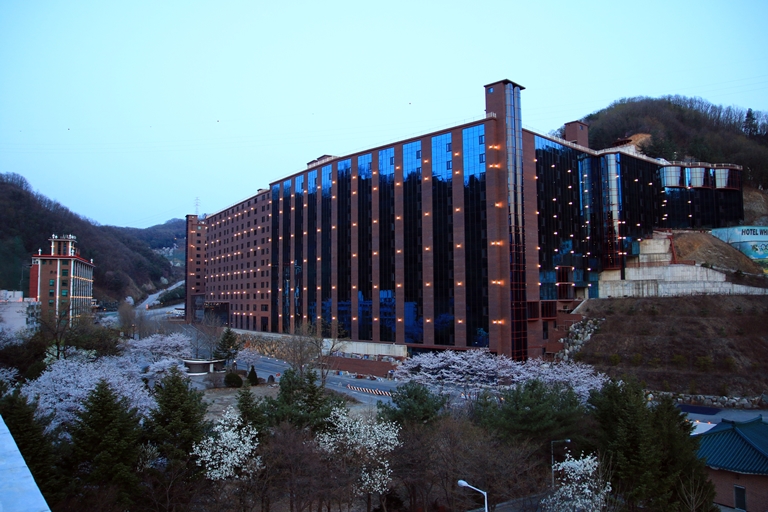
A Holy Temple Inspired by Noah's Ark:
When we left the Culture Center, which was at the highest site of the complex, we saw a park with a small stage. Its name is ‘Mountain Park.’ It is a place where people can perform outdoors, and it was a unique atmosphere where people can look down the mountain and enjoy performances in nature. It also serves as a resting spot as it has several benches and is located in the middle of the walkway. After sitting here for a while looking around the surrounding scenery, we decided to return to the entrance of Algok Sports Complex and tour religious facilities.
Around the large cross in front of the main hall's facade of the Algok Seongjeon is a picture of seven angels with trumpets appearing in the book of Revelation and two pigeons biting the Olive Tree leaves. At the top stands a pointed sculpture, shaped like a snail or soft ice cream, symbolizing the fire or torch, which was used in religious rites.
The religious facility, Algok-seongjeon, consists of four facilities, including the main hall and three annexes. While the main hall, which is 13.5 meters high, 27 meters wide and 70 meters long, is a large building, it looked more compact than expected compared to the size of the entire complex. Lee Myung-sun, the head of the church’s construction division, explained that the main building was built with meaning rather than size, only half the size of the ‘Noah’s Ark’ in the Bible.

Three other annexes are located near the main hall. The first annex has a chapel, dining room and offices, and the second annex houses Secretariat and General Affairs Department, a rest area and event spaces, while the third annex consists of a lodging facility and dining rooms. In addition, the building, which was used as a research center by the Korea Electrical Safety Corporation for long, has been purchased and is used as another annex now.
At the entrance to the mountain behind the main hall was a two-story waterfall coffee shop. Although it is not open in winter, you can see the waterfall artificially created by drawing water from the mountain valley, and you can feel like you entered a waterfall cave if you sit in the coffee shop. In front of the main hall, there is a large square and a stage, a place where the church holds various outdoor events.
Famous sports facilities in Gapyeong:
After touring the Algok-seongjeon Complex in the mountains, we returned to the Beotkkot-gil Rest Area to see related facilities. Standing across from the rest area, the largest building seen around is the Sangcheon Recreation Center. The Recreation Center consists of two separate buildings, the main building and an annex having the Eiffel Tower model. It started as a youth hostel in 2001 and has recently been used as a training center for youth and adult organizations. It has a room that can accommodate 800 people, a convention hall where 1,200 people can be in action, and a seminar room.
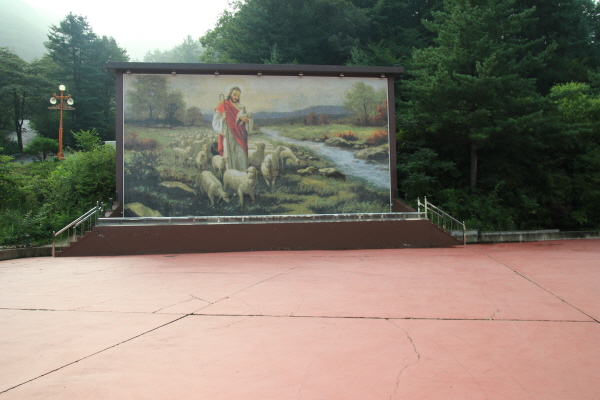
The advantages of Sangcheon Recreation Center are that rooms account for only 30% of the whole facility and other auxiliary facilities, such as sports and workshop facilities, account for 70%, so they are not crowded with people and can be used pleasantly. It also has indoor tennis and survival games venues, which are often used by various organizations and companies for group vacations or workshops.
The indoor tennis court in the training center uses the same standard and flooring materials as the U.S. Open, and the walls are glass windows, keeping people from feeling heavy. Athletes from the Gyeonggi Provincial Government and from the university teams frequently train here. The Recreation Center at the time of Youth Hostel had such excellent facilities that it had been designated as the best youth hostel for three times (2002, 2004 and 2005) by the Korea Youth Hostel Federation.
Next to the rest area is the Eden Sports Center and next to the Hotel Whitestone is the Eden Golf Driving Range. The sports center houses an indoor gymnasium where people can play ball games in addition to swimming pools and bowling alleys.
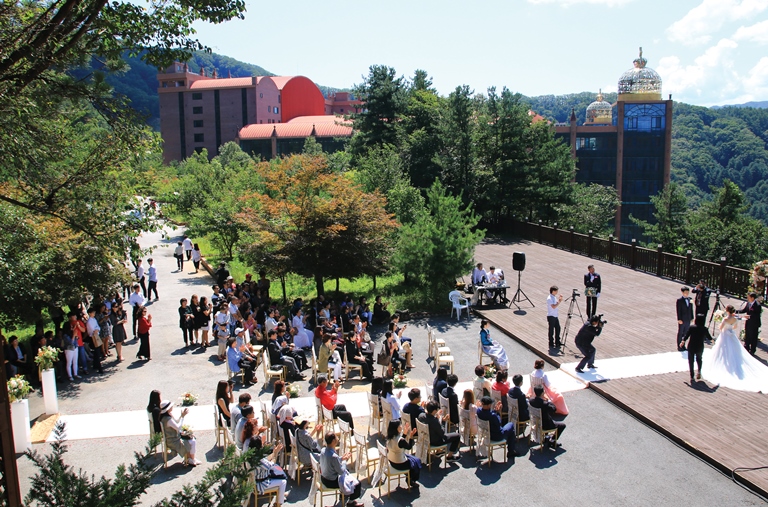
Since the pool is equipped with six adult lanes and a pool of young children and uses natural water drawn from 100 meters underground in Sangcheon-ri, it is not usually chlorine disinfection carried out in the pool to sterilize tap water. In this swimming pool, various swimming competitions are held in Gyeonggi-do and training sessions also take place for young swimming talent.
The indoor gymnasium, which is in the second floors of the sports center, has courts and equipment that allow various games such as volleyball, basketball and tennis, and has 600 seats of attendance, which is why it hosts various types of sports competitions in Gyeonggi Province and Gapyeong County. The bowling alley has 12 lanes and is open to individual and group lessons.
The Eden Golf Driving Range is a seven-story building with one basement floor, 250 yards and 94 practice bats, a screen golf room, a golf shop and a lounge, as well as an Eden Golf Academy that fosters golf talent. The Eden Golf Academy has produced LPGA pros, including Anna Lin and Ko Na-hye, and KPGA pros, including Lee Joon, the Eden Golf Driving Range Coach, and Jung Ji-woong, the 2017 KPGA Part Two Tour Winner, and currently has about 50 trainees.
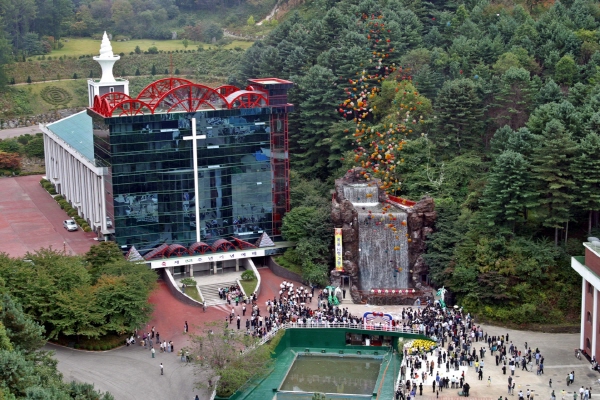
The sports facilities next to the rest area were originally designed for use by the church members, but now large sports centers have been created because residents of Gyeonggi Province and Gapyeong County wanted to use them, and suggestions were made to supplement the facilities, said Yoon Sang-hak, director of communications.
In addition to the training center and the sports center at the center of rest areas, large facilities such as the Honeymoon Wedding Hall, Eden Park Motel and Eden Agricultural Products Center were also built, and convenience facilities such as restaurants, a gas station, a car center and a hospital (neurosurgeons) seem to form a community of their own.
Who created the Large Culture and Sports Complex and how?
It took us half a day to make a brief tour of all the facilities of the Algok-seongjeon of the Holy Eden Church. The walkway that runs through all of these places is an hour-and-a-half course that takes an adult's walk. It's not far from Seoul, and it has fresh air, and it also has scenic hiking trails and walking paths, so it can be explored as a tourist destination.
Anyone would visit the Holy Eden Church and Amusement Park any time. If you use a private car, you can find the Edenbeotkkot-gil Rest Area on Route 46 of the Gyeongchun National Road, or take the bus 1330-2, 1330-3 at Cheongnyangni Station, and get off at Cho-ok dong (Eden Sports Town). If you get off at Sangcheon Station (between Cheongpyeong Railroad Station and Gapyeong Station) of the Gyeongchun Line, you can take a shuttle bus to Algok-seongjeon.
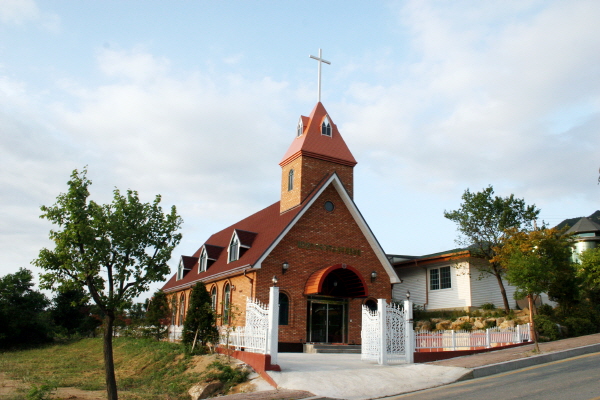
After looking around the facilities, we were told in detail by Holy Eden church officials about the development of the Algok-seongjeon and related facilities. Church officials said the purchase of the land by the Holy Eden Church was more than 30 years ago which dates back to 1985.
Interview with Dr. Yoon, the communications director:
Director Yoon of communications gave answers to the Korea Post questions as follows:
Question: I am surprised that a religious organization has such a large site in the Gyeonggi Province, which is close to Seoul. How big is it and when did you purchase the land?
Answer: 280,000 square meters of land was purchased in 1985 and we began building the temple. The Reverend Lee Young-soo, who opened the Holy Eden Church in 1973, received a message from God in 1980, "Build my temple and honor me in a secluded place about an hour from Seoul." Later in September 1985, when he found and bought a good forest land. Immediately after the purchase, construction on the temple was started and completed in 1987. Building facilities one by one, we have come over here.
Q: Building a temple in the mountains must have cost a lot of money. Did the construction cost come from donations from the believers?
A: If you build this big complex and you don't have any debt, people won’t believe it, but it's true. We don’t have a contractor or a construction company. We didn't get any outside investment. We have been building with our hands. The design was done by Reverend Lee Young-soo and the construction was done by volunteers. Our church members took turns in the construction work. When it comes to costs, the Holy Eden Church never forced donations. This is the reason that it took 30 years in total to build all these buildings. We have carried out construction only when we have got voluntary donations from believers.
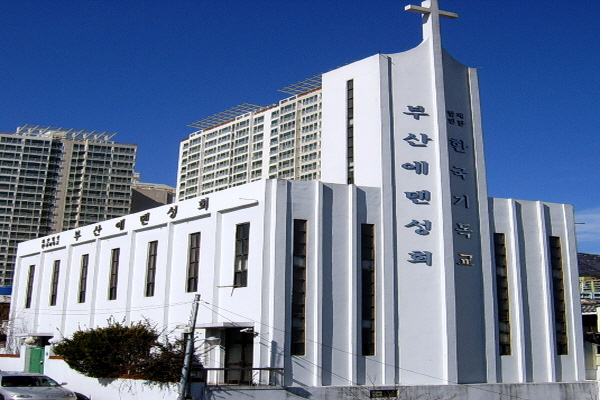
Q: Honestly, the exterior of the buildings is quite unique. Some buildings were constructed on very steep slopes.
A: Using the shapes of crosses, flames, and archangels, and the red color symbolizing the blood of Jesus, it may be a little different from normal buildings, but I am proud to say that it is harmonizing well with the natural environment. If the appearance and location seem a little strange to the public, it was not built by a general construction company, but it was done just as Reverend Lee Young-soo received command from God. He is a religious man who has never learned anything about architecture, and even a middle school dropout. Nevertheless, it is amazing that we have created structures that ordinary people can't easily imagine and built them without a single accident of death.
Q: Looking back at the Algok-seongjeon Complex, the most curious thing was the purpose of a religious organization called the Holy Eden Church here to create a hotel, a big performance hall, an amusement park and a gym. Wouldn't you have built facilities in more populous areas for the sake of the future or for the profit, or started active publicity by attracting outside investment and opening more facilities quickly? Why have you built all kinds of facilities in the mountains for over 30 years?
A: This is to publicize the work of God to the world. Our aim is to draw attention and focus attention and preach the gospel. Various cultural facilities are a means to bring people together with interest. To that end, the church plans to attract large-scale performances along with the promotion of the Culture Center and Hotel Whitestone to promote the Algok-seongjeon Complex at home and abroad.
It is good to see that a culture and sports complex has been established in the northeastern part of Gyeonggi Province, which lacks cultural facilities anyway. Is there anyone who wouldn't want to enjoy their leisure activities such as culture, sports, plays, lodging and dining out in a place with beautiful air and natural environment at once? I do hope it will become a tourist attraction globally as well as in Korea.
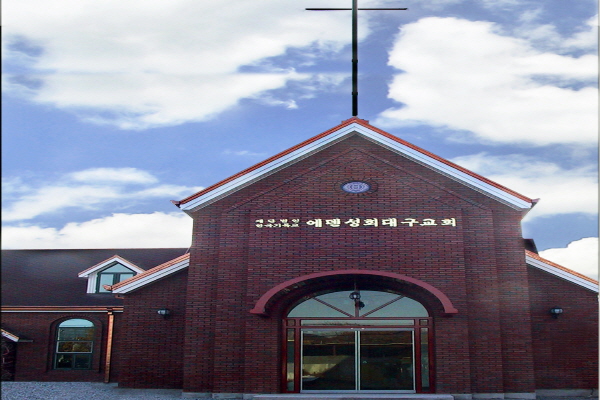
Q: Please introduce Reverend Lee Young-soo:
A: Reverend Lee Young-soo is the prophet prophesied as the Second Olive Tree of the Two Olive Trees and one of Jesus’ two witnesses (Zechariah 4:14, Revelation 11:34). The Olive Tree is God’s servant that is predestined to appear during the final days in God's plan. Lee Young-soo had his first audience with God in April 1970 and was taught every three days over three years by God and Jesus to do the work of the Olive Tree. He was shown many visions even after then. His book ‘Visions from God’ is to introduce some of the visions he saw in the form of pictures. You can see the book in the site of the church (http://ieden.kr/en).
In 1974, Jehovah said to Lee Young-soo, "What I’told my young servant Zechariah 2,500 years ago will come true in your time." This was to let him know that the work of the Olive Tree prophesied through Zechariah would be fulfilled in his days.
When Jesus ascended to Heaven after his crucifixion and resurrection, he was rewarded with the power to rule over Heaven while sitting on the throne to the right of God (Psalms110:1). At that time, he received a book sealed with seven seals in God’s right hand (Revelation 5:7). The book contained God’s secret plan, and Jesus, after reading the book, came to realize God’s will completely.
So that Jesus learned that he had to appoint the two Olive Trees for the final days. Therefore, Jesus, in the book of Revelation, prophesied that he would assign the two Olive Trees as his witnesses (Revelation 11:3-4). In order to choose the one as the Olive Tree, he waited for the one who overcomes (Revelation 2, 3). The Overcomer refers to the one who has overcome Jesus’ tests for the one to harvest in the last days as Olive Tree.
Jesus would have him carry on God’s work to be fulfilled during the final days. The work is to complete God’s army, which is the last harvest.
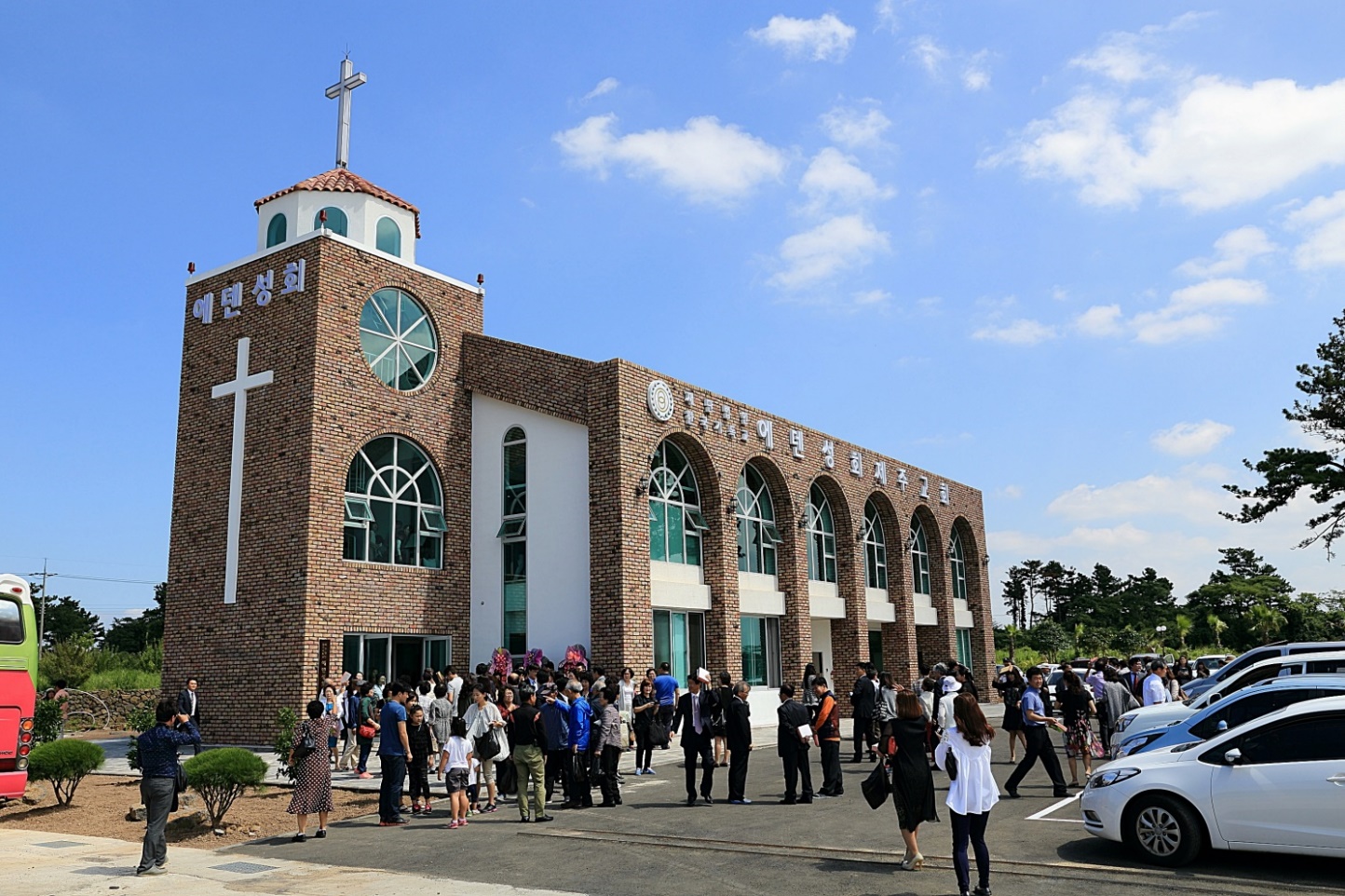
The responsibility of the Olive Tree is to prepare his followers as the soldiers of heaven, that they may receive Jesus’ seal, (Revelation 7:3) and then harvest the ripe ones in dedication to God (Revelation 14:16). To receive the seal, they must be fruitful grains. And those who would become fruitful are to be ripened at the temple of God (Revelation 14:15). That temple is Algok-seongjeon, which Jehovah asked Reverend Lee Young-soo to build today.
Therefore, Reverend Lee must teach God's will to his followers so that they may become fruitful grains as soldiers of heaven. When he completes the number of soldiers God commanded him to fill, Jesus can use what has been accomplished on earth to achieve his mission in heaven.
After the spread of Christianity in Korea in the 19th century, many were martyred. When it was time for Jesus to appoint the Olive Tree in accordance with God’s will, he saw that Korea had become the most fruitful place. Therefore, Jesus decided to appoint the two Olive Trees in Korea and revealed his prophecies to several people during the Japanese colonial period.
Jesus chose the two Olive Trees during the Korean War. At the time, Lee Young-soo was nine and did not even know Jesus. However, Jesus anointed him, along with the First Olive Tree, thereby appointing him as the Second Olive Tree. Since then, Jesus trained him through hardships and prepared him for his mission.
Lee Young-soo was born in 1942. In 1958, when he was 16, he started attending Jeondogwan, the evangelical church built by the First Olive Tree. In 1962, when he was 20, he was appointed as a preacher for Jeondogwan. He was a preacher for six years before he took a leave of absence in 1968.
Jesus told Lee that the First Olive Tree carried out God’s work honestly for only three years. God decided to initiate the Second Olive Tree earlier than planned. However, since the First Olive Tree refused to pass on God’s work to the Second Olive Tree, God commanded Lee to carry out his work separately.
In April 1970, Jesus visited him and took him to meet God. It was there, in God’s world, that he received his mission to become God’s servant, and it was there he was shown the Holy City, the New Jerusalem, to be built in God’s world in the future.
Since then, he has seen numerous visions. In some, he saw a Bible littered with blank spaces, which hid God's will. God taught him his plan through the scenes shown within the blanks of the book. In other visions, he saw his name recorded in the Lamb's Book of Life (Revelation 3:5, 21:27), had his sins washed away by Jesus, and learned that the blood of Jesus would be delivered through him. Devils also came to him in these visions, harassing him and taking him to the Devil’s world where he saw the Devil King.
Jesus told him that there were 90,000 people who had received God’s blessing through the former servant. Jesus asked him to save those among them who still truly seek God.
Following God’s commands, he started Holy Eden Church in Jeonnong-dong, Dongdaemun-gu on November 17, 1973.
In April 1980, Jehovah commanded him, "Build my temple in a quiet place an hour away from Seoul and bring glory to me," and showed him the temple to be built. That's because it is the place where the prophecy, "Take your sickle and reap, because the time to reap has come, for the harvest of the earth is ripe," (Revelation 14:15) will come true. The temple was named ‘Algok-seongjeon’ to symbolize the grains being harvested and stored in Heaven.
In September 1985, according to Jehovah’s command to build the Algok-seongjeon, Reverend Lee purchased property in the mountains of Cheongpyeong-myun, Gapyeong-gun, Gyeonggi-do. On November 8, 1987, he finished building the temple and dedicated it to God. In December 1987, God promised him the following: "You did great work on building my temple under difficult circumstances. I will make you noble from now on." Since then, God has shown him annex buildings to be built, one at a time, and has given him the guidance to build them. In May 1990, Jehovah gave him words of blessing, saying "Your followers will enter my world through this temple."
Following God’s instructions, Reverend Lee continues to build a sports complex, a large-scale theater (Culture Center), and a hotel (Hotel White Stone) in Algok-seongjeon Complex to let God’s work be known to the world.
In 2012, ‘Echo of Eden,’ the collection of Lee Young-soo’s sermons in 20 volumes was published. In 2014, his visions have been illustrated and published in ‘Visions from God.’ Now the pictures are displayed in the Culture Center so that the world may see that God’s final work is being accomplished there.
For further details on the Holy Eden Church, please visit http://ieden.kr/en.

